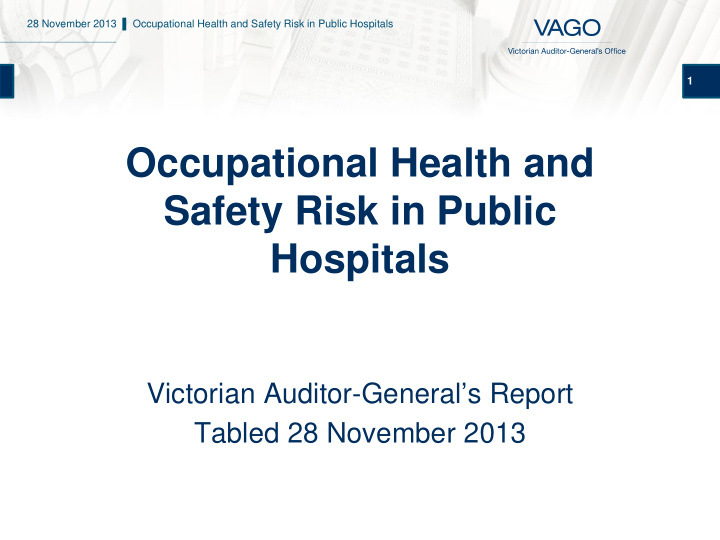



28 November 2013 ▌ Occupational Health and Safety Risk in Public Hospitals 1 Occupational Health and Safety Risk in Public Hospitals Victorian Auditor-General’s Report Tabled 28 November 2013
28 November 2013 ▌ Occupational Health and Safety Risk in Public Hospitals Background 2 pages Occupational health and safety (OHS) covers 1–5 employee health, safety and welfare in the workplace. OHS is particularly important in public hospitals because: • of the major hazards that exist • patient care can also be affected if a staff member is injured.
28 November 2013 ▌ Occupational Health and Safety Risk in Public Hospitals Background – continued 3 pages OHS is also costly. The WorkCover premium paid 1–5 by Victorian public hospitals is substantial, with over $80 million paid in 2012–13 alone. OHS affects many workers. Hospitals are the largest employer group in the public sector.
28 November 2013 ▌ Occupational Health and Safety Risk in Public Hospitals Audit objective and scope 4 page 3 To examine the effectiveness of the management of OHS risk in public hospitals. The audit examined the role of health services—as employers, the Department of Health—as manager of the health system, and WorkSafe—as the regulator. Four health services were also audited: • two large metropolitan services • one large regional service • one small rural hospital.
28 November 2013 ▌ Occupational Health and Safety Risk in Public Hospitals Audit method 5 page 3 The following data collection methods were used: • review of documentation • structured interviews with managers and staff • survey of OHS directors in 15 of the largest health services • safety climate survey offered to all employees in the four audited hospitals.
28 November 2013 ▌ Occupational Health and Safety Risk in Public Hospitals Conclusion 6 page x Public hospital staff are put at unnecessary risk while at work. This is because: • management is not systematic or comprehensive • the department as the health system manager does not monitor sector-wide OHS risks or emerging trends in public hospitals • WorkSafe as the OHS regulator does not know if its project activity reduces OHS risk.
28 November 2013 ▌ Occupational Health and Safety Risk in Public Hospitals Findings at hospital worksites 7 page x • Insufficient priority and accountability for OHS in public hospitals. • Information on OHS incidents and risks is incomplete. • Hospital management is not fully informed of OHS risk.
28 November 2013 ▌ Occupational Health and Safety Risk in Public Hospitals Findings at hospital worksites – continued 8 • The incident reporting system used by public hospitals page 17 is not fit-for-purpose. • Safety inspections by hospital staff varied widely, pages despite worksites sharing common OHS risks. 19 • There is little analysis of the factors causing OHS page 20 incidents. • Existing information on OHS risk is not routinely pages integrated or prioritised. 21
28 November 2013 ▌ Occupational Health and Safety Risk in Public Hospitals Sector-wide findings 9 Neither the department nor WorkSafe has a comprehensive page 24 understanding of sector-wide OHS risk because they don’t currently monitor OHS incidents and emerging trends. WorkSafe does not know whether its projects have been page 27 effective in reducing OHS risk in public hospitals. This is because: • its selection of hospital worksites for projects was not based on clear criteria or systematic • project objectives were not clear • performance was not measured regularly against stated indicators.
28 November 2013 ▌ Occupational Health and Safety Risk in Public Hospitals Impact during the audit 10 • WorkSafe has acknowledged shortcomings with its page 21 current project management framework and is developing a new model to target risk across all industries. • The department and WorkSafe have been working collaboratively in recent months. • The Building Board Capability Advisory Committee has now incorporated OHS, and the learning from VAGO’s OHS audit, into its approach to building board capability in 2014.
28 November 2013 ▌ Occupational Health and Safety Risk in Public Hospitals Recommendations 11 Accept 1. That public hospitals and health services give higher priority to, and ensure accountability for, the management of OHS. 2. That the Department of Health requires public hospitals and health services to annually assure it that they: • manage OHS through a systematic approach in accordance with relevant legislation and standards. • provide workers with the highest level of protection against risks to their health and safety that is reasonably practical in the circumstances. 3. That WorkSafe provides support to the boards of public hospitals and health services on OHS leadership and requirements to raise awareness of their responsibilities to comply with OHS laws so that public hospital staff receive the highest practicable level of OHS protection.
28 November 2013 ▌ Occupational Health and Safety Risk in Public Hospitals Recommendations – continued 12 Accept 4. That public hospitals and health services implement a systematic and integrated approach to OHS that complies with the Australian Standard on OHS management systems, AS4801, or an equivalent standard. 5. That while public hospital industry OHS risk remains significant compared to other industries, WorkSafe annually confirms to the Department of Health that public hospitals and health services: • comply with OHS legislation • have in place a systematic approach to the control of OHS risks and that effective risk control mechanisms exist. 6. That WorkSafe identifies sector-wide OHS risks in public hospitals and provides this information to the Department of Health, public hospitals and health services. 7. That the Department of Health and WorkSafe collaborate to assist public hospitals and health services to control the highest OHS risks.
28 November 2013 ▌ Occupational Health and Safety Risk in Public Hospitals Contact details 13 For further information on this presentation please contact: Victorian Auditor-General’s Office [p] 8601 7000 [w] www.audit.vic.gov.au/about_us/contact_us.aspx
Recommend
More recommend